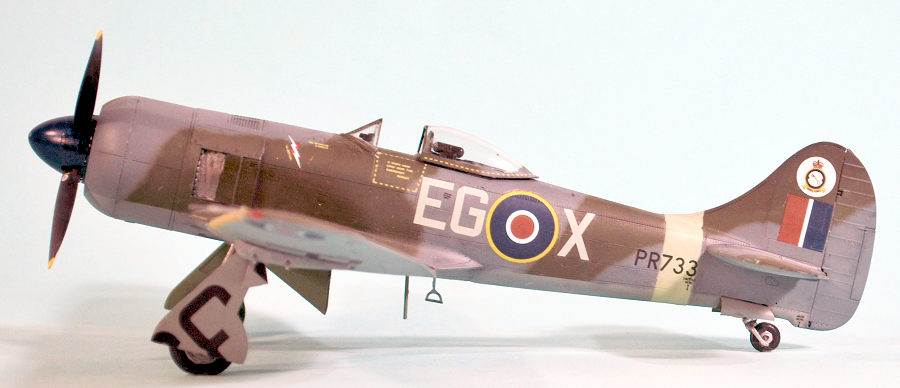
Special Hobby 1/48 Tempest II
| KIT #: | 48214 |
| PRICE: | $74.00 |
| DECALS: | Five Options |
| REVIEWER: | Tom Cleaver |
| NOTES: |

| HISTORY |
The Tempest, which was first called the Typhoon II, was Sydney Camm’s response to the shortcomings of the original Typhoon fighter, most particularly the Typhoon's unexpected deterioration in performance at high altitude due to its too-thick wing, by replacing that with a thinner laminar flow design. As the design began to significantly diverge from the Typhoon, it was renamed Tempest; it became one of the most powerful fighters of World War II and was the fastest single-engine piston-engine aircraft of the war at low altitude.
Sydney Camm always had his next design in mind when developing his current project, and the Hawker design team had already planned out a series of design improvements by the time the Typhoon prototype first flew. The result was the Hawker P. 1012, otherwise known as the Typhoon II or Thin-Wing Typhoon. In March 1940, Hawker engineers investigated the new laminar flow wing developed by NACA in the United States. Using this data, the maximum thickness of the Tempest wing was set at 37.5% of chord versus 30% for the Typhoon's wing, reducing wing root thickness by five inches on the new design. The wing planform was changed to near-elliptical to accommodate 800 rounds of ammunition for the four 20 mm Hispano cannon.
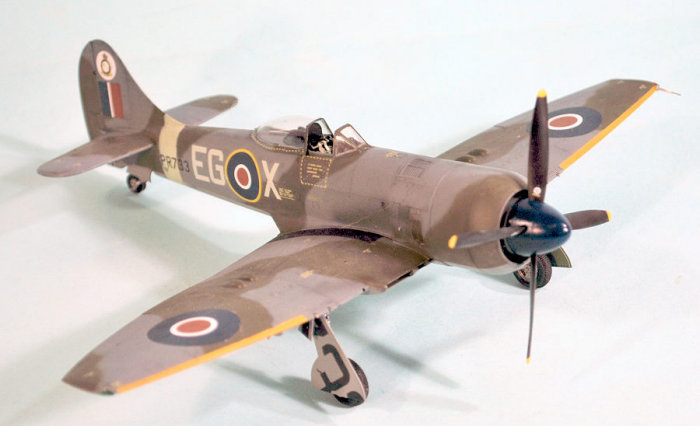 As with the Typhoon and
Tornado, different powerplants were proposed for the design. Six prototypes were
built: a single Mk.I, HM599, powered by a Sabre IV; two Mk.IIs with the
Centaurus IV radial; a single Mk.III with a Griffon IIB and a Mk.IV with a
Griffon 61; and a Mk.V with the Sabre II in an installation similar to that of
the Typhoon. Ultimately, the Mk.V prototype flew first The Tempest II was
subject to repeated delays due to its Centaurus engine, but was persisted with,
while continued problems with the Sabre IV ended the Tempest I, while the
decision to use the Griffon in the Spitfire stopped further development of the
Tempest III and IV. The Mk. V, which had the least difficulty with its engine
due to the work on the Typhoon, became the main type produced.
As with the Typhoon and
Tornado, different powerplants were proposed for the design. Six prototypes were
built: a single Mk.I, HM599, powered by a Sabre IV; two Mk.IIs with the
Centaurus IV radial; a single Mk.III with a Griffon IIB and a Mk.IV with a
Griffon 61; and a Mk.V with the Sabre II in an installation similar to that of
the Typhoon. Ultimately, the Mk.V prototype flew first The Tempest II was
subject to repeated delays due to its Centaurus engine, but was persisted with,
while continued problems with the Sabre IV ended the Tempest I, while the
decision to use the Griffon in the Spitfire stopped further development of the
Tempest III and IV. The Mk. V, which had the least difficulty with its engine
due to the work on the Typhoon, became the main type produced.
The Tempest II benefitted from examination of captured Fw-190s, which led to it and the Grumman F8F having the most closley-cowled radials of any Allied fighters. The Centaurus engine was closely cowled and the exhaust stacks grouped behind and to either side of the engine; air outlets with automatic sliding "gills" behind that with the carburetor air intakesin the inner leading edges of both wings with an additional oil cooler in the inner starboard wing.
The first Tempest II, LA602, flew June 28, 1943, powered by a Centaurus IV with a four-blade propeller. The second, LA607,had the enlarged dorsal fin associated with the Tempest and flew on September 18. The first major problem experienced was serious engine vibration, which were cured by replacing the rigid, eight-point engine mountings with six-point rubber-packed shock mounts. The four blade propeller was replaced with a five blade unit before a more finely-balanced four bladed unit was adopted. Problems with engine overheating, poor crankshaft lubrication, exhaust malfunctions and reduction-gear seizures delayed production. The eventual solution was the “tropicalized” modification with the installation of an air filter and intake in the upper forward fuselage, just behind the engine cowling, using a louvered outlet just ahead of the fuselage gas tank; this was retroactively fitted to earlier Tempests in F.B. II production and was original after the first 50.
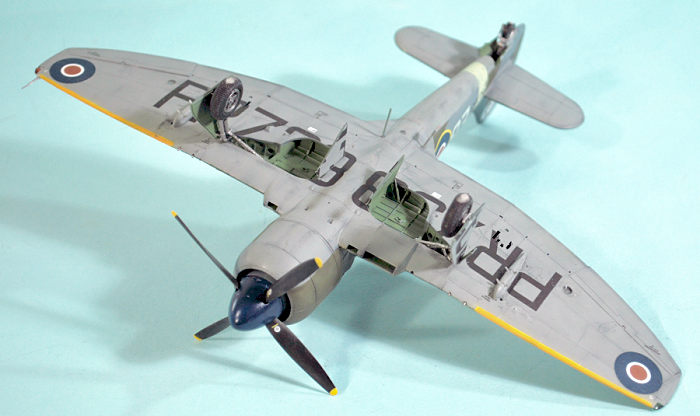 In September 1942
contracts were signed for 500 Tempest IIs to be built by Gloster but because of
priority being given to the Typhoon, a contract of 330 Tempest IIs was allocated
instead to Bristol, while Hawker were to build 1,800, a switch that further
delayed production. The first Tempest II came off the Hawker line on October 4,
1944; the first six production aircraft joined the prototypes for extensive
trials and tests.With the end of the war in sight, orders for the Tempest II
were cut or cancelled: Bristol production stopped after 50, and Hawker
eventually built 402 in two production batches: 100 built as pure fighters, and
302 F.B. II fighter-bombers with reinforced wings and wing racks capable of
carrying bombs of up to 1,000 lb or eight RPs.
In September 1942
contracts were signed for 500 Tempest IIs to be built by Gloster but because of
priority being given to the Typhoon, a contract of 330 Tempest IIs was allocated
instead to Bristol, while Hawker were to build 1,800, a switch that further
delayed production. The first Tempest II came off the Hawker line on October 4,
1944; the first six production aircraft joined the prototypes for extensive
trials and tests.With the end of the war in sight, orders for the Tempest II
were cut or cancelled: Bristol production stopped after 50, and Hawker
eventually built 402 in two production batches: 100 built as pure fighters, and
302 F.B. II fighter-bombers with reinforced wings and wing racks capable of
carrying bombs of up to 1,000 lb or eight RPs.
The Tempest II had the best performance of the series, with a maximum speed of 442 mph at 15,200 ft, climb rate to the same altitude of 4.5 minutes compared with 5 minutes for the Tempest V, and service ceiling of 37,500 ft. All production aircraft were powered by a 2,590 hp Centaurus V driving a 12 ft 9 inch Rotol propeller. The Tempest II would have formed the fighter component of Tiger Force, a proposed British Commonwealth long-range bomber force based on Okinawam, however the Pacific War ended before they could be deployed.
By October 1945, a total of 320 Tempest IIs had been delivered. The aircraft were sent to squadrons in Germany and India. A Tempest II flown by Roland Beamont, led the flypast at the London Victory Celebrations of June 8,1946. The sole combat use of RAF Tempest IIs was against guerrillas of the Malayan Races Liberation Army during the early stages of the Malayan Emergency.
| THE KIT |
The Special Hobby 1/48 Tempest II was released this past May. Other than subject matter and markings options, it has nothing to do design-wise with their larger 1/32 kit. This is a modification of the Eduard Tempest V kit, with a different sprue for the radial engine and prop and other different details, as well as sub-type-specific wings and fuselage parts.
| CONSTRUCTION |
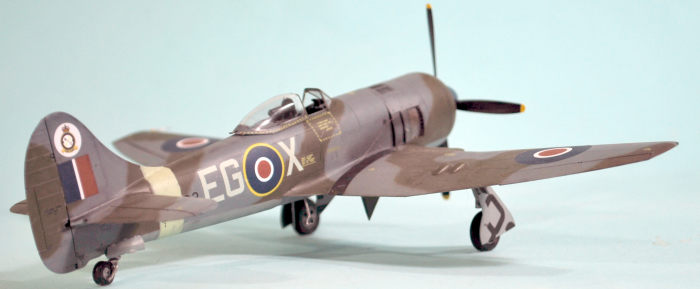 This kit assembles in a
manner similar to the Eduard Tempest V kit. The kit maintains the Eduard
reputation for being “fiddly,” and care must be taken throughout the
construction to insure all sprue nibs and any minor flash are cleaned off the
parts, since they fit very precisely. That said, the end result is worth the
extra effort taken during construction.
This kit assembles in a
manner similar to the Eduard Tempest V kit. The kit maintains the Eduard
reputation for being “fiddly,” and care must be taken throughout the
construction to insure all sprue nibs and any minor flash are cleaned off the
parts, since they fit very precisely. That said, the end result is worth the
extra effort taken during construction.
The fit of parts is really tight. Also, there are a lot of small parts on the sprues, and they have really delicate sprue gates attaching them to the sprue. It is very easy to knock one off unnoticed while cutting another part off the sprue, with that small part disappearing forever, to drive you nuts when you come to the point in the instructions where you are directed to attach it. “Where the @#$##@!! is it?!” you will be crying. HANDLE THESE SPRUES WITH EXTREME CARE.
First, as regards the
cockpit: I suggest you use the plastic instrument panel assembly with decals; it
will ultimately fit better than the photo-etch pieces when it comes to
shoehorning into the fuselage. Additionally, if you do not use all the
photo-etc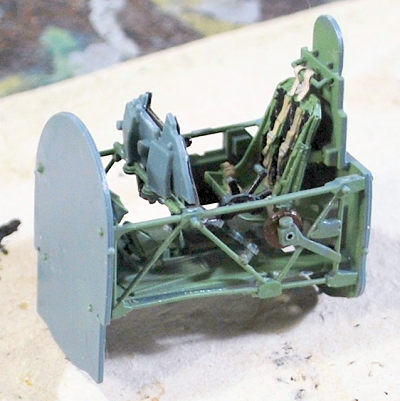 h levers, you will not miss anything; almost all the detail parts will
not be visible in the cockpit once assembled.
h levers, you will not miss anything; almost all the detail parts will
not be visible in the cockpit once assembled.
If you cut off the little locating pins on the outside of the cockpit assembly, it is easy to pop it into the fuselage and slide it into position. With the fuselage assembled and the joints set up, there will be no problems associated with later assembly after you get the cockpit into position.
The final difficult bit is the wing sub-assembly. When you assemble the parts of the wheel well into the upper wing, DO NOT attach part E79 (the inner gear door retraction mechanism) to Part E48 (the inner gear well bulkhead) as the instructions would have you do. Save that part and attach it with tweezers (it’s easy) once you are at final assembly and putting the landing gear and doors into position. Otherwise, you are guaranteed to knock off the retraction mechanism. Also, go through the instructions and find all the parts that should be attached inside the wells and do them now. DO NOT WAIT till you come across that instruction later - you’ll likely have knocked the part off the sprue by then.
Unlike the Tempest V, the wing assembles easily. The trailing edge joint runs right along the trailing edge of the flap, rather than through it, so there is no joint filling, sanding and rescribing necessary. The wing fits to the fuselage easily. If you are careful with the fuselage and wing sub-assemblies, you won’t have to use any gap filler, and you won’t lose any of that beautiful surface detail.
The horizontal stabilizers and the control surfaces are easy. Assemble as they fit.
| COLORS & MARKINGS |
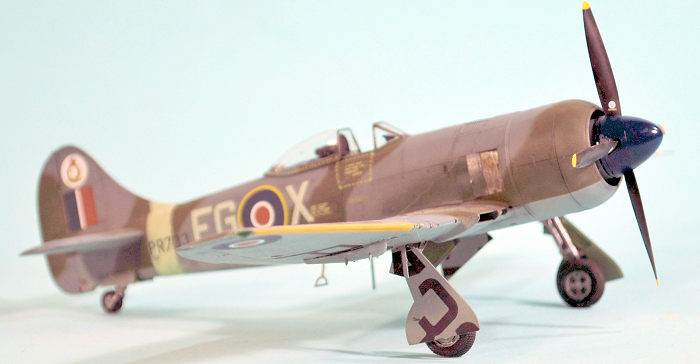 I painted and masked the
yellow wing leading edges and the Sky fuselage band, then pre-shaded the model
with black, then did the standard Temperate Land Scheme with Tamiya XF81 Ocean
Grey, XF-82 RAF Dark Green and XF-83 Sea Grey Medium.
I painted and masked the
yellow wing leading edges and the Sky fuselage band, then pre-shaded the model
with black, then did the standard Temperate Land Scheme with Tamiya XF81 Ocean
Grey, XF-82 RAF Dark Green and XF-83 Sea Grey Medium.
The decals are thin, but opaque, and went down under an application of Solvaset, melting into the surface detail without problem.
I gave the model an overall coat of clear “flat,” then attached the landing gear and posed the canopy open and attached the prop.
The kit does not include a set of bomb racks, so I used the bomb racks from a Hasegawa Typhoon (since they were the same for both) and called it finished.
| CONCLUSIONS |
This is a really nice kit. Eduard is releasing the kit as the “early” Tempest II with different decals next month to coincide with the IPMS-USA Nationals.
15 July 2021
Copyright ModelingMadness.com. All rights reserved. No reproduction in part or in whole without express permission
Review Kit courtesy of Special Hobby
If you would like your product reviewed fairly and fairly quickly, please contact the editor or see other details in the Note to Contributors.